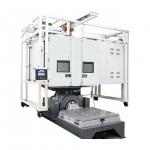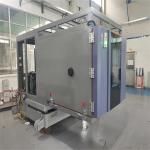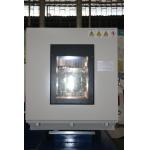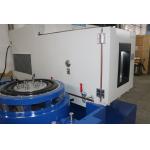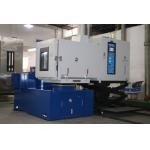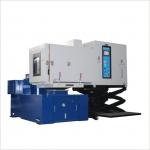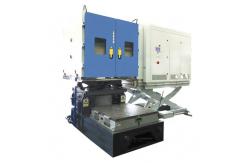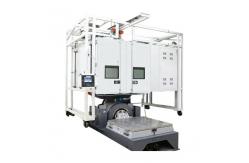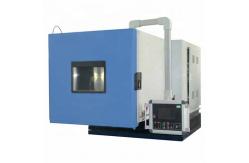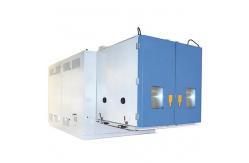In the highly competitive landscape of modern manufacturing and
research, ensuring the reliability and durability of products is
non-negotiable. The Climatic Environmental AGREE Test Chamber, a
sophisticated and versatile piece of equipment, emerges as a
crucial tool for industries ranging from aerospace and defense to
electronics and automotive. The Climatic Environmental AGREE Test Chamber, which combines
constant temperature, humidity, and vibration testing capabilities,
is designed to subject products and components to a comprehensive
range of environmental stressors. Named after the military standard
"Advisory Group on Reliability of Electronic Equipment" (AGREE),
this chamber serves the primary purpose of evaluating how products
will perform and endure under the complex and often harsh
conditions they may encounter during their operational lifetimes.
By simulating a combination of temperature extremes, humidity
levels, and mechanical vibrations, it allows manufacturers and
researchers to identify potential weaknesses, optimize designs, and
ensure compliance with industry-specific standards and regulations. - Robust and Integrated Construction
- The chamber is constructed with a heavy-duty framework, typically
made of high-strength steel, to withstand the rigors of
simultaneous temperature, humidity, and vibration testing. The
interior is lined with a non-reactive and smooth surface, such as
stainless steel or a specialized polymer, to prevent any
interaction between the chamber environment and the tested
specimens. The insulation is of top-notch quality, ensuring minimal
heat and moisture transfer, which is essential for maintaining
precise temperature and humidity control. The vibration system is
integrated seamlessly into the chamber structure, with vibration
tables or platforms that can be adjusted to accommodate different
sizes and weights of samples. The door of the chamber is engineered
for a tight seal, featuring a reliable locking mechanism and a
heavy-duty gasket. It also includes a large viewing window, usually
made of tempered glass with anti-fog and anti-scratch properties,
allowing for continuous visual monitoring of the testing process
without disturbing the internal environment.
- Precision Environmental and Vibration Control Systems
- Temperature Control: The temperature control system is highly
accurate and can maintain a wide temperature range, typically from
-70°C to +150°C, with an accuracy of ±0.3°C. It utilizes advanced
refrigeration and heating technologies, along with a sophisticated
feedback loop and multiple temperature sensors strategically placed
throughout the chamber. This ensures uniform temperature
distribution and rapid temperature change capabilities, essential
for efficient testing. The system also has built-in safety features
to prevent overheating or overcooling, protecting both the samples
and the chamber itself.
- Humidity Control: The humidity control system is equally precise,
capable of adjusting the relative humidity from 5% to 95% RH, with
an accuracy of ±2% RH. The chamber is equipped with a
high-efficiency humidifier and dehumidifier, which work in harmony
to achieve rapid and accurate humidity adjustments. Special care is
taken to prevent condensation, which could affect the test results
and damage the samples. The system also features a dew point
control function, which is crucial for maintaining the correct
moisture balance in the chamber.
- Vibration Control: The vibration control system is designed to
generate a wide range of vibration frequencies and amplitudes. It
can simulate various vibration profiles, from simple sinusoidal
waves to complex random vibrations that mimic real-world conditions
such as those experienced during transportation or in operational
machinery. The system is highly programmable, allowing users to
create and store custom vibration sequences. It also has built-in
safety features to prevent excessive vibrations that could damage
the samples or the chamber. The control panel for the vibration
system is user-friendly and intuitive, enabling easy setup and
adjustment of vibration parameters.
- Programmability: The overall control panel of the chamber is highly
programmable, allowing users to create and store complex test
profiles that combine temperature, humidity, and vibration
settings. This enables the simulation of a wide variety of
environmental and operational scenarios. For example, it can mimic
the conditions that a military electronic device might experience
during a mission, including rapid temperature changes, high
humidity, and intense vibrations. The control panel displays the
current status of all parameters, including temperature, humidity,
vibration frequency, and amplitude, as well as the progress of the
test program.
- Advanced Instrumentation and Data Acquisition
- The chamber is outfitted with a comprehensive suite of sensors.
Temperature sensors are distributed evenly to detect any
temperature gradients and ensure a homogeneous thermal environment.
Humidity sensors provide real-time data on the relative humidity
levels. Vibration sensors measure the amplitude, frequency, and
acceleration of the vibrations. These sensors are connected to a
state-of-the-art data acquisition system that records and stores
all the measured data. The data can be accessed and analyzed in
real-time or retrieved later for in-depth studies. The data
acquisition system is highly flexible and can be integrated with
external software and databases, facilitating seamless data
transfer and analysis. It can also be configured to send
notifications and reports automatically, saving time and effort for
the users. Additionally, the control panel includes built-in alarms
and safety features that alert users in case of any abnormal
conditions, such as temperature or humidity excursions outside the
set limits, power failures, or equipment malfunctions.
- Volume and Dimensions: The chamber is available in various sizes to accommodate
different testing requirements. The volume can range from a few
cubic feet for testing small components to larger chambers with
several cubic meters of space for testing more substantial products
or multiple samples. The interior dimensions are carefully designed
to optimize the distribution of temperature, humidity, and
vibration, ensuring that all parts of the tested samples experience
consistent environmental and mechanical stress. The external
dimensions are configured to fit within a standard laboratory or
production facility, taking into account factors such as access,
ventilation, and clearance.
- Temperature Uniformity: The temperature uniformity within the chamber is maintained
within ±0.5°C. This ensures that all parts of the tested samples
experience a similar thermal environment, which is crucial for
obtaining accurate and reliable test results.
- Humidity Uniformity: The humidity uniformity is within ±3% RH. This level of
consistency in humidity distribution allows for precise testing of
samples that are sensitive to moisture levels.
- Vibration Uniformity: The vibration system is designed to provide uniform vibration
across the testing platform. The variation in vibration amplitude
and frequency is kept within a very small tolerance, typically ±5%,
ensuring that all parts of the sample are subjected to the same
mechanical stress.
- Stability: Both the temperature and humidity stability are excellent, with
minimal fluctuations over time. The vibration system also offers
high stability, maintaining the set vibration parameters accurately
throughout the test. This allows for long-term testing and the
evaluation of a sample's performance under stable environmental and
mechanical conditions, as well as its ability to withstand changes
over extended periods.
- Accurate Simulation of Complex Environmental and Operational
Conditions
- The primary function of this chamber is to provide a highly
accurate and realistic simulation of specific temperature,
humidity, and vibration conditions. By precisely controlling these
parameters, it allows users to evaluate how products and samples
will behave in various real-world situations. For example, in the
aerospace industry, it can test the performance of avionics
components under the extreme temperature and humidity changes that
occur at high altitudes, combined with the vibrations experienced
during flight. In the automotive industry, it can assess the
durability of engine parts and electronics under the combined
stress of engine vibrations, temperature fluctuations, and humidity
levels.
- The ability to create complex test profiles that combine different
environmental and vibration conditions is also a valuable function.
This can help in uncovering potential weaknesses or failure points
in products that may not be evident under single-parameter testing.
For instance, a product that functions well under static
temperature and humidity conditions may fail when subjected to
simultaneous vibrations and rapid temperature changes. The chamber
can accurately replicate such scenarios to determine the product's
true durability and performance limits.
- Enhanced Product Quality and Research Capabilities
- Through comprehensive testing in the chamber, manufacturers can
identify and address potential issues in their products. If a
product shows signs of degradation or failure under specific
temperature, humidity, and vibration conditions, appropriate
measures can be taken, such as modifying the design, changing the
material composition, or improving the manufacturing process. This
leads to the development of more stable and reliable products,
reducing the risk of failures and recalls. In the research field,
it allows for the exploration of new materials and the
understanding of their properties under combined environmental and
mechanical stress, which can lead to significant scientific
breakthroughs.
- The test chamber also serves as a valuable tool for quality
control. By subjecting products to standardized tests that mimic
real-world conditions, manufacturers can ensure that their products
meet the required quality and performance standards. This helps in
building customer trust and maintaining a good reputation in the
market.
- Compliance with Industry Standards and Regulations
- Many industries have strict standards and regulations regarding
product testing under specific temperature, humidity, and vibration
conditions. The Climatic Environmental AGREE Test Chamber is a
reliable tool for ensuring compliance. For example, in the
aerospace and defense industries, components must meet stringent
standards for reliability and durability. In the electronics
industry, products need to withstand a range of environmental and
mechanical stresses to ensure proper operation. By using this
chamber to conduct tests in accordance with relevant standards,
manufacturers can prove that their products meet the necessary
criteria, facilitating market access and enhancing consumer
confidence. Regulatory bodies rely on accurate test results
obtained from such chambers to enforce safety and quality
regulations.
- Stringent Manufacturing Process
- The Climatic Environmental AGREE Test Chamber is manufactured under
strict quality control procedures. Each component, from the
insulation panels to the environmental and vibration control
systems, is carefully sourced and inspected for quality and
performance. The assembly process is carried out by highly trained
technicians in a clean and controlled environment, ensuring the
proper installation and functionality of all parts.
- The calibration of the temperature, humidity, vibration, and other
sensors and control systems is a critical and regular part of the
manufacturing process. It is performed using traceable reference
standards to guarantee the accuracy and reproducibility of the test
results. Rigorous quality audits and inspections are conducted at
various stages of production to maintain the highest level of
product quality.
- Quality Certification and Validation
Our chamber has obtained relevant quality certifications and has
been validated by independent testing laboratories. It has been
proven to provide accurate and reliable test results, conforming to
the relevant international and national standards. We also
continuously update and improve our product based on the latest
technological advancements and customer feedback to ensure its
long-term performance and compliance.
- Aerospace Industry
- An aerospace component manufacturer used the Climatic Environmental
AGREE Test Chamber to test a new type of satellite communication
module. The tests, which included exposure to extreme cold and
vacuum conditions combined with high-frequency vibrations, revealed
|
